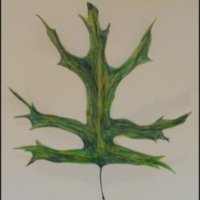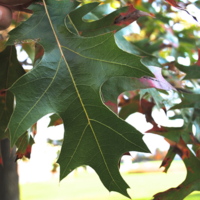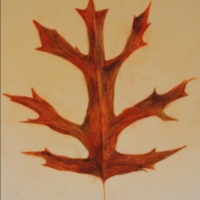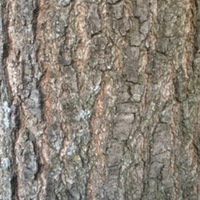Pin Oak : Pin Oak - Characteristics
The pin oak has many unique and intriguing characteristics. The tree takes on a pyramid shape in early stages in life and as it ages, grows into an oval shape. Fast growth and ability to survive in a variety of soils makes the tree an incredibly adaptive species. The tree grows best in full sun and grows to 60 to 70 feet high with a 25 to 45 feet spread. Being a fairly short lived species, the pin oak reaches maturity between 80 and 100 years. The unique shape of the pin oak includes, upper branches that are upright, middle branches that are horizontal, and lower branches that slant toward the ground. The tree can be incredibly easy to transplant as well. The shallow, fibrous root system makes the tree very reliable. Because of this, the pin oak is not known to suffer from strangle roots very often. Strangle roots occur when the roots begin to wrap around the base of the tree trunk, causing endangerment to the tree’s life. The bark of the tree is tight and smooth and develops small fissures as it ages. Fissures are cracks or long narrow openings in the bark of the tree. Pin oaks are also monoecious, meaning the tree has separate male and female flowers on the same plant.
Leaves:
The leaves of the pin oak are glossy dark green that turn a beautiful russet, bronze, or red in the fall. They are smaller than those of similar species, with blades only ranging to about 4 inches. The leaves have deep sinuses, that extend 2/3 or more to the midrib separating 5 (sometimes 7 to 9) lobes. A sinus of a leaf is the space in between the lobes that do not break the structure of the leaf. They are also classified as simple, which means the leaves have an undivided blade, and alternate, meaning a single leaf is attached at a node. For most of the winter months, many of the pin oaks are marcescent, providing shelter for roosting birds. Marcescent means that the leaves of the tree are withering, but remain attached to the stem. It is common for these leaves to remain throughout the winter until the new growth gives them the extra push to let go. The reason for this is abscission has not taken place. Abscission is the term used for the shedding of the oak’s leaves. Thus, the pin oaks are known for the quiet rustling the dried up leaves make when they are stroked by a winter breeze.
Fruits and Flowers:
The characteristics of the pin oak’s fruits and flowers are very similar to those of other red oaks. The pin oaks acorns are small, averaging about a half of an inch wide, and have a very shallow cap. It takes the acorns around 16 to 18 months to full maturity. At this time, the acorn then turns reddish, light brown color as it prepares to drop. The acorns are dropped during the fall, from September to December. During this time, the acorns are dispersed by mice, blue jays, squirrels, and woodpeckers. Because the acorns of the pin oak have such a waxy and thick coating, they are able to tolerate and withstand many elements, including being submerged in cold water for many months at a time. When located near shallow pond like areas, the acorns are very popular among waterfowl.




